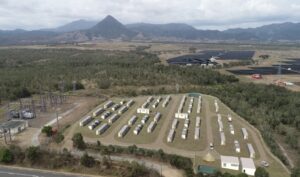The latest NSW tender for wind, solar and long duration storage has received bids representing more than three times the capacity sought as the state seeks to bulk up its grid ahead of the impending closure of the country’s biggest coal fired power station.
AEMO Services, which is conducting the tender for the NSW government as part of the state’s infrastructure roadmap, says it has received bids for 3.1GW of new generation capacity, more than three times the 950MW of new capacity sought.
The long term storage component has received offers of 1.6GW of capacity (with a minimum of eight hours storage, or at least 13 gigawatt hours), also around three times the 550MW of storage capacity sought in the tender.
The tender is the third to be conducted by the NSW government as it races to ensure there is enough capacity in the grid to fill the gaps created by the planned closure of the 2.8GW Eraring coal plant in August, 2025, and other ageing coal generators in the years to follow.
One tender has been completed, with 1.4GW of new capacity awarded to wind and solar projects, and just 50MW for long term storage. Another tender, focusing on two hour “firming” needs closer to the state’s major load centres, has been expanded from 380MW to 930MW after a deal with the federal government.
The NSW government is offering what are called “long term energy service agreements” (LTESA’s) that are effectively a floor price that provide some certainty for revenue, and which allow developers to seek better terms for finance and equity.
AEMO Services chair Paul May says the LTESAs address a key market risk that might otherwise delay or discourage investors.
“The insurance provided by an LTESA is attracting strong support from investors,” May said in a statement.
“Combined, the bids for generation represent a total capacity of 3.1GW, against an indicative target of 950MW for this tender, and bids for long-duration storage represent a total capacity of 1.6GW, against a target of up to 550MW.”
Moy noted that more than half of the projects in the current tender had been submitted in the first tender.“We designed our processes to minimise time and effort for repeat bidders – allowing participants to sharpen their pencils and return with an improved proposition,” May said.
The first tender delivered prices at around 40 per cent below the levellised cost of wind and solar. That does not represent the actual cost of the projects, because it is only a floor price, but does minimise costs to NSW and electricity consumers.
However, a large chunk of the first tender went to a single project, the 720MW New England solar farm, where construction was already well under way on its first stage 400MW stage (pictured above).
The tender is limited to projects that have not yet reached financial close, but is open to those that may have started construction.
And while a three-fold oversubscription to the tenders may sound extremely good, it contrasts to the 10-fold response to the expressions of interest sought for many of the new renewable energy zones that are being created in NSW.
The difference could be explained by the fact that the pricing tenders are limited to those projects with planning approval, and very few projects have received planning approval in recent years.
One major focus of the tender will be the technologies offered in the long-durations storage component.
The first tender was won by a first-of-its-kind eight-hour lithium-ion battery storage project to be build by German energy giant RWE, although the project was relatively small in terms of capacity at 50MW and 400MWh of storage.
Pumped hydro projects are finding it difficult to compete, given the rising costs of these and many other civil construction projects, and the framing of the tender guidelines.
It is thought that the capacity offered in the latest tender will be battery storage, although it will be interesting to see if there are competing technologies such as flow batteries, which have gained a foothold in Queensland, for instance, or compressed air storage, like one proposed for Broken Hill.
AEMO Services executive general manager Paul Verschuer said that the strength of competition in the tender would secure value for NSW energy consumers.
“The competing bids will now undergo an assessment for non-price criteria such as deliverability, and benefits to local communities and First Nations people, after which we’ll assess them closely to determine the most valuable projects for consumers.
“We have the flexibility to only select the projects that represent the best value to consumers. If we aren’t satisfied that there are enough competing projects we can alter our plan accordingly and tender for a higher volume in future rounds.
“Likewise, if we do see sufficient value we can increase the amount of energy supported.
“In our first tender, this approach produced a line-up of successful projects willing to build the necessary energy generating infrastructure, while putting much less consumer money at risk than traditional CFD’s by contracting LTESA strike prices 40% below the levellized cost of energy.”
CFDs are “contracts for difference,” used by other states such as the ACT government.
Those contracts, which include agreement to return revenue in excess of the agreed strike price to consumers, has protected ACT consumers from big bill increases, but the prices are generally higher to guarantee a return on investment above the LCOE.
The ACT will have to make up the difference if wholesale prices fall below that CFD price. The LTESAs are seen, in financial market terms, more as a “put option” to be exercised only if the renewable or storage project is struggling to meet debt obligations.
The results of this tender will be released before the end of the year, and a third tender for generation and long duration storage will be opened in October. Bids for the two hour “firming” tender will close later this month.








